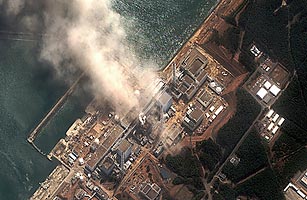
For the second time in three harrowing days, a hydrogen explosion at one of Japan’s crippled reactors at the Fukushima Daiichi nuclear plant blew the roof off a containment building — this time on Monday morning at reactor unit No. 3. Eleven workers at the plant were injured, and the force of the blast apparently damaged a pump that workers had brought in to douse the reactor’s fuel rods with seawater — the stopgap method they are using to cool the fuel rods in the wake of the tsunami that on Friday disabled the electric generator powering the reactors’ cooling system. The same sort of explosion devastated reactor unit No. 1 on Saturday, sending plumes of white smoke into the air. Monday’s blast was yet further evidence of the difficulties Japanese authorities are encountering as they try to prevent what could be a calamitous nuclear accident.
Late on Monday, officials announced that the problems at the Fukushima plant were intensifying: Chief Cabinet Secretary Yukio Edano said the cooling system at reactor unit No. 2 had also failed and that TEPCO was going to try to flood that unit with seawater, just as it was doing at the other two crippled reactors, to try to cool off the fuel rods.
As grim as the news is, the situation is not yet a calamity. Critically, the fuel rods at Fukushima remain inside their steel containment vessels, and there is no indication that those vessels have been damaged. Moreover, though some radiation has been released into the air in order to reduce pressure inside the troubled reactors, Edano said on Monday that atmospheric radiation was not at a dangerous level and that the government believes it is “unlikely” that large amounts of radiation will be released into the atmosphere. Still, more than 200,000 Japanese who live within a 12-mile radius of the nuclear plant have been evacuated as a precaution.
Experts differ in their opinions on whether a large-scale radiation release can be avoided in Fukushima, as it was in Pennsylvania 32 years ago. Edward Lyman, a senior scientist at the U.S.-based Union of Concerned Scientists, cites a study by Sandia National Laboratories titled “Risk-Informed Assessment of Degraded Containment Vessels” that notes that the type of reactors at work at Fukushima are “unusually vulnerable to containment failure in the event of a core melt accident.” The most likely failure scenario, Lyman says, “involves the molten fuel burning through the reactor vessel, spilling onto the containment floor and spreading until it contacts and breeches the steel containment-vessel wall.” He acknowledges that it’s “not straightforward to interpret [the results of the Sandia study] in the context of the very complicated and uncertain situation at Fukushima. But they are a clear indication of a worrisome vulnerability of the [containment vessel] should the core completely melt and escape the reactor vessel.”
The key is to avoid a “core melt accident,” which is why TEPCO workers are frantically trying to pump seawater into all three of the damaged reactors. But as Monday drew to a close in Japan, it wasn’t clear if the Fukushima plant had moved away from the worst-case scenario, or if the latest explosion meant it had drawn even closer.
See pictures of an aging nuclear plant.
See pictures of the worst nuclear disasters.